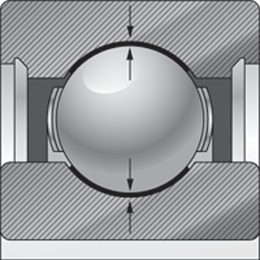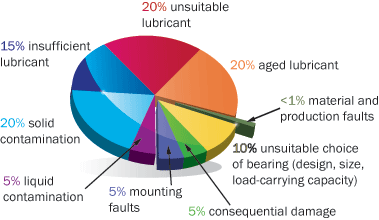5 Ways to Prevent Bearing Failures
The accurate diagnosis of a bearing failure is imperative to prevent repeat failures and additional expense. Rolling bearings are precision machine elements found in a wide variety of applications. They are typically very reliable even under the toughest conditions. Under normal operating conditions, bearings have a substantial service life, which is expressed as either a period of time or as the total number of rotations before the rolling elements or inner and outer rings fatigue or fail. According to research, less than 1 percent of rolling bearings do not reach their expected life.

Premature Bearing Failure
When a bearing does fail prematurely, it usually is due to causes that could have been avoided. For this reason, the possibility of reaching conclusions about the cause of a defect by means of studying its appearance is very useful. It's most important to correct the causes and prevent future failures and the costs that follow.
Most bearing failures such as flaking, pitting, spalling, unusual wear patterns, rust, corrosion, creeping, skewing, etc., are usually attributed to a relatively small group of causes that are often interrelated and correctable. These causes include lubrication, mounting, operational stress, bearing selection and environmental influence.
Proper Lubrication
The purpose of lubricating a bearing is to cover the rolling and sliding contact surfaces with a thin oil film to avoid direct metal-to-metal contact. When done effectively, this reduces friction and abrasion, transports heat generated by friction, prolongs service life, prevents rust and corrosion, and keeps foreign objects and contamination away from rolling elements.
Grease typically is used for lubricating bearings because it is easy to handle and simplifies the sealing system, while oil lubrication is more suitable for high-speed or high-temperature operations.
Generally, lubrication failures occur due to:
- Using the wrong type of lubricant
- Too little grease/oil
- Too much grease/oil
- Mixing of grease/oil
- Contamination of the grease/oil by objects or water
Grease Service Life
In addition to the normal bearing service life, it is also important to take into consideration the normal grease service life. Grease service life is the time over which proper bearing function is sustained by a particular quantity and category of grease. This is especially crucial in pump, compressor, motor and super-precision applications.
Mounting and Installation of Bearings
In the mounting and installation process, it is critical to use proper tools and ovens/induction heaters. Employ a sleeve to impact the entire inner ring face being press fit. Also, verify the shaft and housing tolerances. If the fit is too tight, you will create too much preload. If the fit is too loose, you will generate too little preload, which may allow the shaft to rotate or creep in the bearing. Don't forget to check for proper diameters, roundness and chamfer radius.
Be sure to avoid misalignment or shaft deflection. This is particularly significant in mounting bearings that have separable components such as cylindrical roller bearings where successful load bearing and optimal life are established or diminished at installation.

You must also be aware of the radial internal clearance (RIC) and maintain the proper RIC that was established in the original design. The standard scale in order of ascending clearance is C2, C0, C3, C4 and C5. The proper clearance for the application is important in that it allows for the challenges of lubrication, shaft fit and heat.
Keep in mind that a proper film of lubricant must be established between the rolling elements. Reducing internal clearance and impeding lubricant flow can lead to premature failure. With regards to shaft fit, it is inevitable that there can be a reduction in the radial internal clearance when the bearing is press fit. Also, in the normal operation of bearings, heat is produced, which creates thermal expansion of the inner and outer rings. This can reduce the internal clearance, which will reduce the optimal bearing life.
Operational Stress and Bearing Selection
Generally, it is the exception to find a bearing that has been improperly designed into an application. However, factors within the larger application may change. If loads become too high, overloading and early fatigue may follow. If they are too low, skidding and improper loading of the rolling elements occur. Early failure will follow in each situation. Similar issues arise with improper internal clearance.
The first sign of these issues will be unusual noises and/or increased temperatures. Bearing temperatures typically rise with start-up and stabilize at a temperature slightly lower than at start-up (normally 10 to 40 degrees C higher than room temperature). A desirable bearing temperature is below 100 degrees C.
There are typical abnormal bearing sounds that reveal certain issues in the bearing application. While this is a subjective test, it is helpful to know that a screech or howling sound usually indicates too large an internal clearance or poor lubrication on a cylindrical roller bearing, while a crunching felt when the shaft is rotated by hand normally suggests contamination of the raceways.
Operational stresses in the application can impact bearing life as well. It is essential to isolate vibrations in associated equipment, as they can cause uneven running and unusual noises.
| Sound | Other Indicators | Causes |
|---|---|---|
| Hiss | Small bearings | Raceway, ball or roller surfaces are rough |
| Buzz to roar | Loudness and pitch change with speed | Resonation; poor fit; bearing rings deformed; vibration of raceways, balls or rollers; brinelling |
| Crunch | Felt when bearing is rotated by hand | Scoring of raceway surfaces, scoring of balls or rollers, dust / contamination |
| Hum | Disappears when power supply is shut off | Electromagnetic sound of motor |
| Clatter | Noticeable at low speeds, continuous at high speeds | Bumping in cage pockets due to insufficient lubricant |
| Screech/howl | Occurs mainly on cylindrical roller bearings, sound changes with speed, goes away temporarily with lubrication | Large radial clearance, poor lubrication |
| Squeak | Metal-to-metal spalling sound, high pitch | Small clearance |
| Squeal | Generated irregularly due to grating | Slipping of fitting surfaces |
| Rustle | Sound quality remains the same even if speed changes | Dirt or raceways, ball or roller surfaces are rough |
| Growl | Continuous at high speeds | Scoring on raceway, balls or rollers |
| Quiet fizzing or popping | Generated irregularly on small bearings | Bursting sound of bubbles in grease Large sound pressure |
| Large sound pressure | Large sound pressure |
Rough raceway, roller or ball surfaces; raceways, rollers or balls deformed by wear; large internal clearance due to wear
|
Environmental Influence
Even with the best design, lubrication and installation, failures will occur if the operating environment is not taken into consideration. While there are many potential issues, the primary ones include:
-
Dust and dirt, which can aggressively contaminate a bearing. Special care should be given to using proper sealing techniques.
-
Aggressive media or water. Once again, sealing is key. The use of specialty-type seals that do not score the shaft is recommended.
-
External heat. The ambient operating temperature mandates many choices in radial internal clearance, high-temperature lubricants, intermittent or continuous running and other factors that affect bearing life.
-
Current passage or electrolytic corrosion. If current is allowed to flow through the rolling elements, sparks can create pitting or fluting on the bearing surfaces. This can be corrected by creating a bypass circuit for the current or by using insulation on or within the bearing. This should be an inherent design consideration in applications such as wind turbines and all power-generating equipment.
Remember, the first step in the overall prevention of bearing failure lies in the consideration of bearing technologies that are most suitable to the application with regard to specifications, recommendations, maintenance strategies, fatigue life and wear resistance of the bearing. Premature bearing failure within a proper application is typically attributed to one or more of the causes discussed (lubrication, mounting, operational stress, bearing selection or environmental influence), which can and should be corrected in order to avoid future bearing failures and additional cost.
